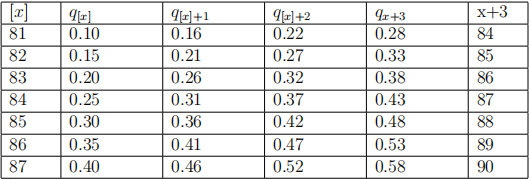STATS 3G03: Assignment 2
Hello, dear friend, you can consult us at any time if you have any questions, add WeChat: daixieit
STATS 3G03: Assignment 2
1. a) The survival function for a newborn is given by a straight line until the maximum achievable age M. What is the maximum age M if the life expectancy is 60 years?
b) Using your survival function from part (a), find the survival function for a 25 year old.
c) A company is hiring 25 year olds who will stay with the company until age 65, or until death, whichever comes first. Using your answer to part (b), what is the expected time that they are with the company?
2. For this problem, use a survival function with a constant force of mortality of 5%.
a) Compute the probabilities for the first 4 curtate ages at death (0, 1, 2, and 3).
b) if you consider a maximum term of 4 years only, what is the curtate term expected lifetime and the standard deviation of the that curtate time for a maximum of 4 years? (We did not write a formula for the above standard deviation; I am looking for you to determine how that might be calculated)
3. a) Make the first 8 years of a life table using a radix of 100,000 where the  is found by TRUNCATING (not rounding) the decimal number of survivors you get using a survival function of
is found by TRUNCATING (not rounding) the decimal number of survivors you get using a survival function of

Include on your table 
b) Use your life table to find 
OPTIONAL: You can do this problem on Excel, and upload the Excel sheet to the drop box. In Excel, truncation is done using the int() function. However, you MUST construct the spreadsheet from scratch on your own. ANY use of another person’s Excel sheet will result in both the original author and the person copying being charged with academic dishonesty. This is a very serious matter. If using Excel, you absolutely must create your own spreadsheet from scratch. If you are helping another person (and you are encouraged to do so), NEVER send them an electronic copy of your spreadsheet.
4. Consider the life table:

a) What is  using two approaches: UDD, and then a constant force of mortality.
using two approaches: UDD, and then a constant force of mortality.
b) What is the difference in those two values?
5. You are given the following select and ultimate table.

a) Compute 
b) Compute 
c) Compute the probability that an 83-year old person who was sold insurance 2 years ago will die in the two years between the ages of 85 and 87.
6. An investment of $10,000 increases to $10,690 after 8 months.
a) What is the annual nominal rate with monthly compounding?
b) What is the equivalent annual nominal rate with semiannual compounding?
c) What is the equivalent annual effective rate?
d) What is the equivalent continuously compounding rate?
Answer part a) as a percentage accurate to 4 decimal places, like 12.3456%, and the rest as a percentage accurate to 3 decimal places.
2021-10-19